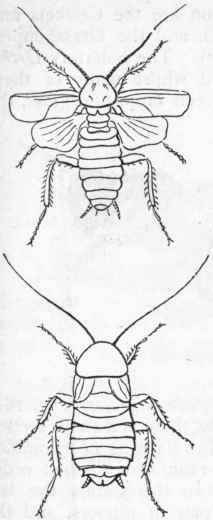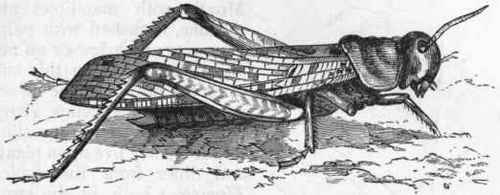Order VI. Orthoptera
Description
This section is from the "" book, by .
Order VI. Orthoptera
Mouth masticatory; wings four, sometimes wanting ; the anterior pair mostly smaller than the posterior, semi - coriaceous or leathery, usually with numerous nervures, the interspaces between which are filled with many transverse reticulations; sometimes overlapping horizontally (Cockroach), sometimes meeting like the roof of a house (Grasshoppers). Posterior wings usually having their front portion of a different texture from their hinder portion, this latter being almost always more transparent, and when not in use folded longitudinally like a fan. Posterior wings often wanting in the females of the Blattidae. Antennas usually filiform. Metamorphosis semi - incomplete (sometimes, however, the adult is apterous, when it becomes almost impossible to distinguish the larva, pupa, and imago).

Fig. 183. - Orthoptera. The common Cockroach (Blatta orienta-lis), male and female.
This order includes a number of well-known insects, most of which are vegetable-feeders. Some of the Orthoptera, such as the Cockroaches (Blattidae, fig. 183) have slender legs, and are adapted for running (cursorial). Others are suited for walking, and are said to be gressorial. Amongst these are the Mantides, with their great raptorial front-legs, and the singular Walking Leaves and Stick-insects (the Phasmidae). Others, again, are saltatorial, having the hind-legs elongated and adapted for leaping, In this section are the Crickets and Mole-crickets (Gryllidae or Achetidae), and the Grasshoppers and Locusts (Acridiidae and Locustidae). The Saltatory Ortho-ptera are all vegetable - feeders, and whilst many of them commit serious depredations upon green crops and grass, the ravages of the Migratory Locust (OEdipoda migratoria, fig. 184) are in this respect unrivalled. Finally, there is a small section of the Orthoptera, which includes the Earwigs (Forficulidce), and which has been raised to the rank of a distinct order under the name of Euplexoptera. In this group, the last segment of the abdomen carries a pair of nippers, and the anterior wings are very short, the posterior wings are membranous, and are folded up both longitudinally and transversely, being useless for flight.

Fig. 184. - Migratory Locust (OEdipoda migratoria).
Continue to:


